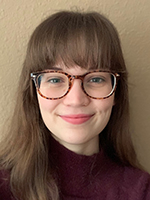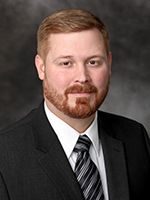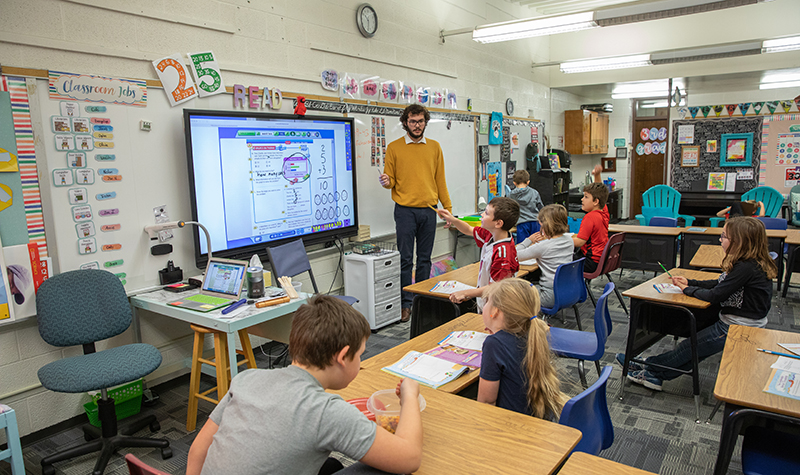How UND’s teachers-in-training navigate COVID-19
Students in ‘Methods and Materials’ class earn field experience through virtual collaborations, tutoring

As a UND senior pursuing a teaching degree, Grand Forks native McKenzie Johnson is at a point in her education where the rubber meets the road.
For her, and every senior in UND’s teacher education programs, this is the year when all of the lessons, lectures and long hours of studying come into practice.
But, of course, this is no ordinary year.
Before the spring, when Johnson will work through her semester-long “internship” of student teaching, she needs to complete the last class along the education track – Methods and Materials.

Her course instructor, Assistant Professor Ryan Summers, described the course as a “soft run” at what it’s like to be a student teacher. In Summers’ case, he’s teaching students such as Johnson how to be science teachers for middle and high schoolers. Methods and Materials courses also exist to prepare teachers for other subject areas such as social studies, English and math.
“The course is designed to take what they’ve learned from the sciences, and all of what they’ve learned at the College of Education & Human Development, and help them understand what it means to teach science,” the professor explained.
Over the course of any other fall semester in UND’s recent history, Johnson would be accumulating around 60 hours of field experience to satisfy this Methods and Materials course – observing experienced teachers, helping youngsters through lessons and eventually planning and carrying out some of those lessons.
But as school districts started to plan how they would bring kids back to school, such a prospect seemed to be in jeopardy.

“Throughout the summer, we were finding out that Grand Forks Public Schools were going to accept our students who were entering the student-teaching portion of the program, but they were kindly asking to not have any of our other students in their classrooms,” Summers said. It is a delicate balancing act to promote safe distancing for all students and staff.
This ruled out dozens of students like Johnson who needed field experience hours to be student teachers the following semester. Summers, though, started thinking of ways to still carry out the Methods and Materials curriculum.
“For teachers who are maybe less experienced, this year is likely to be significantly more of a challenge,” explained Summers, citing hybrid classrooms, strains on lesson-planning and students needing help one-on-one. “This is especially true for first-year teachers getting their feet underneath them early in their careers.”
Thus, Summers offered local and regional schools a virtual experience that could ultimately help schoolteachers while giving his own students the classroom participation they needed.
Pairing students one-on-one with teachers, Summers said it was a matter of simply offering assistance.
“Whatever their needs were, we wanted our students to work with them as a partner,” he said.

New perspective through new experience
Now paired with Lacey Dickerman, an 8th Grade Science teacher at Valley Middle School in Grand Forks, for the fall semester, Johnson said she is supporting the class from a distance.
She’s helping in lesson-planning, coming up with break-time activities and learning what it takes to be a teacher. As time goes on, she’s learning about the flexibility and empathy teachers need in an ever-changing classroom environment while taking on more tasks on her own.
“It’s really a new experience, and it’s showing what being a teacher really means,” Johnson said. “Students need extra support during these times, and I’m lucky enough to be someone who helps out.”
Summers worked with all of the students in his course to find similar arrangements, which he said still give students valuable insight. Preparing instructional materials, for instance, or adapting classroom activities for online delivery can be done at a distance.
“Those pieces are a huge part of the normal field experience,” Summers said. “It’s getting them more comfortable with how to take complex science ideas – in the case of my Methods students – and prepare materials to introduce those ideas to middle school and high school students.”
But Johnson’s work at Valley Middle School is also a process of understanding the elements she is missing in this new arrangement. Interestingly, science teacher Dickerman can offer perspective, as she was in Johnson’s position – even at the same school – just one year ago.
“My field experience, compared to McKenzie’s, was vastly different,” said Dickerman.
Including all of the typical experiences mentioned earlier, Dickerman had first-hand experience in developing rapport with students, dealing with behavioral issues and teaching lessons she created – all before moving on to student teach the following semester.
Dickerman has been spending time with Johnson discussing what’s happening in the classroom, how COVID is changing what was ingrained in their teacher education and how Johnson can further prepare for student teaching.
“Something we discuss a lot is that you never really know how to deal with behaviors or form those relationships until you’re doing it on your own,” Dickerman said. “Each situation is different; you only learn how to do these things with practice.”

Working one-on-one with students
But Johnson is in fact getting some of that practice through another type of virtual arrangement, in which she can work one-on-one with students daily.
As the teacher pairings were coming into focus, Summers said that the local school district also expressed interest to position his science students – and other students in Methods and Materials sections – as subject matter experts and tutors.
This was because the school system established an online academy for students who chose to opt out of in-person classrooms for the time being. Providing that option was good for the families who did not want to send their children into schools, but it put teachers in a precarious position of essentially carrying out two different jobs.
“If teachers are teaching in a classroom, with normal hours, then that means they have very little time to prepare online instruction, and it’s not possible to meet with online students,” Summers said.
Thus, Johnson also spends a portion of her week opening up her Google Calendar for online students at South Middle School. Teachers at the school are able to schedule meetings, and Johnson can set up Zoom links for students to access.
The senior works with young students on their assignments, trying to teach what they may have missed in a lesson, or didn’t understand at first. It’s a form of field experience that is letting her work on those aforementioned relationships, as well as her creativity.
Though worried at first that students wouldn’t show up, or be ready to work with a stranger, Johnson said it’s been a great experience. And that’s partly because her work in this capacity addresses one of the bigger challenges for new teachers – learning how to guide students toward understanding, rather than just giving them the answers.
“We really think it has a lot of benefit for our undergraduates,” Summers said. “It’s a huge service to our local school systems that are finding themselves in impossible situations. I really commend these schools for recognizing that these teacher candidates are an incredible asset to them.”
And through the problem-solving of professors such as Summers, in the face of rapidly evolving circumstances, Johnson’s teacher training is right on schedule.



